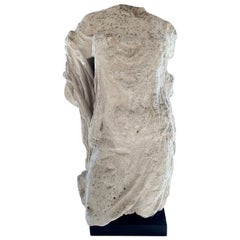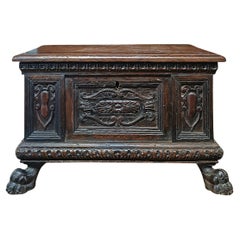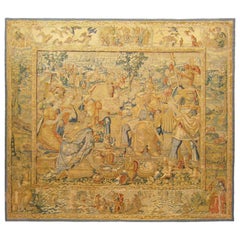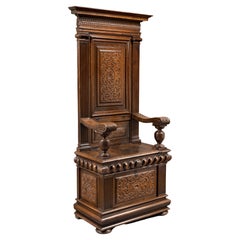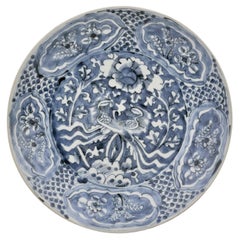16th Century Furniture
to
281
753
384
1,183
36
27
18
7
4
3
1
1
40,733
135,222
547,880
285,403
85,831
261,611
124,694
12,762
5,600
18,665
22,935
19,708
54,414
72,427
61,127
21,702
9,309
422
256
212
164
149
700
275
212
131
116
1,183
1,183
1,183
22
6
3
2
2
Period: 16th Century
16th Century Stone Classical Roman Style Torso
Located in Vosselaar, BE
A wonderful 16th century draped female torso in classical style. Made in France under Italian Renaissance influence this female torso is finely sculpted with great detail to the stol...
Category
French Renaissance Antique 16th Century Furniture
Materials
Sandstone
LATE 16th CENTURY SMALL WALNUT BOX
Located in Firenze, FI
Elegant solid walnut small box, entirely hand-carved. The rectangular chest features an opening top, ideal for storing objects. The front, back, and sides are decorated with geometri...
Category
Italian Renaissance Antique 16th Century Furniture
Materials
Nutwood
Late 16th Century Brussels Historical Tapestry, with Famed Roman General Scipio
Located in New York, NY
A Brussels historical tapestry, attributed to Martin Reymbouts, late 16th century. From the Story of Scipio series, the renowned Roman general, victorious after the Punic War, with k...
Category
Belgian Antique 16th Century Furniture
Materials
Wool
$149,995 Sale Price
25% Off
Renaissance "Chayère" Chair
Located in Saint-Ouen, FR
This chayère chair of beautiful proportions stands on a rectangular box base enriched by vermiculure motifs executed in flat-plane. This base is topped by a moulding of strong gadroo...
Category
French Renaissance Antique 16th Century Furniture
Materials
Walnut
$35,573
Italian Corpus Christi
Located in 'S-HERTOGENBOSCH, NL
Hand-carved Italian Corpus Christi with traces of polychromy.
This sculpture reflects the transition from Gothic to Renaissance style.
Category
Italian Renaissance Antique 16th Century Furniture
Materials
Wood
$2,312
Chinese Swatow Blue and White Ceramic Dish, Late Ming Dynasty
Located in seoul, KR
Famous late ming dynasty chinese blue and white porcelain plate, double phoenix, from the shipwrecked binh thuan
Period: Ming Dyn...
Category
Vietnamese Ming Antique 16th Century Furniture
Materials
Ceramic
Italian School Table of the 16th Century "Crucified Christ with the Virgin"
Located in Madrid, ES
Italian school table of the 16th century
"Crucified Christ with the Virgin, Saint John and Mary Magdalene"
Oil on board
Period frame 16th century ( gold frame parts )
Measures: 41cm ...
Category
Italian Baroque Antique 16th Century Furniture
Materials
Paint
$3,794 Sale Price
20% Off
Polychrome wooden statue depicting Guanyin Bodhisattva, Ming, 16th century
Located in Milano, IT
In a realm where time stands still, there exists a 16th-century masterpiece, a sculpture of unparalleled beauty that transports you to the heart of the Ming dynasty. Here, in a place of reverence and artistry, sits the Chinese Bodhisattva Guanyin, the embodiment of compassion, enshrined in a form of breathtaking elegance.
Guanyin's divine presence is unveiled as he is seated in padmasana, the lotus position, a symbol of purity and enlightenment. His regal robes...
Category
Chinese Ming Antique 16th Century Furniture
Materials
Wood
Rare Late Medieval 16th Century German Wrought Iron Oak Chest
Located in grand Lancy, CH
A very impressive Westphalian Gothic chest or ‚Stollentruhe’, Westphalia, Germany, circa 1500-1550. Wrought iron mounted oak, partially carved. The monumental rectangular standing ch...
Category
German Antique 16th Century Furniture
Materials
Iron
Antique 16th C Ming Jiajing bowl Chinese Porcelain Blue and white Landscape
Located in Amsterdam, Noord Holland
Sharing with you this lovely bowl, painted with a landscape design.
Dating: Jiajing, 16th century.
Condition: some minimal rimfritting, 1 small chip to rim and firing bubble flaw n...
Category
Chinese Ming Antique 16th Century Furniture
Materials
Porcelain
16th century large chest strongbox iron and walnut
Located in Vosselaar, BE
A quite large 16th century Italian so called 'coffre fort' . Coffers or chest like these were specifically made for cities or large villages to safegueard the gold and valuables. The...
Category
Italian Gothic Antique 16th Century Furniture
Materials
Iron
Spanish Azulejo Tile Arista y Cuenca - Toledo 16th century
Located in DELFT, NL
Early Arista y cuenca tile made in Toledo. Tile decorated in renaissance with stylized flowers was probably made between 1550 and 1575.
Category
Spanish Renaissance Antique 16th Century Furniture
Materials
Earthenware
16th Century Renaissance Bed Valane
Located in Canterbury, GB
A Renaissance Bed Valance
Spain or Italy 16th century
From a set of bed hangings originally part of the decor from a castle in France
A long impressive ...
Category
Italian Renaissance Antique 16th Century Furniture
Materials
Metallic Thread
Frans Franken III 16th Century Oil on Wood, Adoration of the Magi, Painting
Located in IT
Frans Franken III and aid, Adoration of the Magi
Good condition
The oil painting on wood, with a gold background, depicts an Adoration of the Magi. The Magi are dressed in sumptuous silk and brocade dresses; they wear precious hats and jewelery. The richness of their garments is in contrast with the humility of the Holy Family and of the other characters who, around curious, observe the scene. The hut is simple, made of wood and straw: above it shines the Comet, symbol of the divine event. In the distance, a group of wayfarers walk along a path that is lost on the horizon, blending into the gold of the bottom.
The representation proposes a traditional iconography, in which the painter inserts some details that he lends himself to symbolic interpretations. Among these is the appearance of the Magi, who from the XIVth century differs iconographically: the wise astronomers represent the homage to Jesus of the then known parts of the world, namely Africa, Asia and Europe. To the right of the Magi, in the foreground, sits a monkey, considered a demonic creature and a symbol of lies and sin. It is depicted on the sidelines, as a defeat, next to a fragment of a classical column: ruin alludes to the end of paganism, of the old world that collapses with the advent of the new one, marked by the birth of Christ and liberation from the Original Sin. On the ruins he climbs the ivy, symbol of the immortality of the soul. The work is attributable to the workshop of the Flemish painter Frans Francken III...
Category
Belgian Renaissance Antique 16th Century Furniture
Materials
Paint
Antique 16th Century German (Augsburg) parcel-gilt Silver-Gold Chalice/Goblet
Located in Doha, QA
This is an absolutely exquisite rare Cooper-gilt ,silver-gold and three Sterling Silver angels Chalice originated from Augsburg (Germany ) in th...
Category
German Renaissance Antique 16th Century Furniture
Materials
Gold, Silver, Copper
16th Wrought Iron Safe, Renaissance Style, for Donations or Cash Chest
Located in Marbella, ES
Impressive wrought iron tabletop safe with engraved decoration and original patina. This type of safe was commonly used in the 16th and 17th centuries to hold valuables, alms, or doc...
Category
Spanish Antique 16th Century Furniture
Materials
Iron
16th century stone architectural fragment
Located in Vosselaar, BE
A 16th century Spanish slate stone architectural fragment. Probably part of a commerative plaque. The Latin inscription only partly present but most likely being a religious referenc...
Category
Spanish Medieval Antique 16th Century Furniture
Materials
Slate
16th Century Cabinet with Knights Carving from Avignon Workshops 'France'
Located in Saint-Ouen, FR
Collection Jean Thuile
Around the mid-sixteenth century French furnishing evolves in its conception and ornamentation. The start of major archi...
Category
French Renaissance Antique 16th Century Furniture
Materials
Walnut
De re hortensi libellus, a 16th Century Children's Gardening Book
Located in Middletown, NY
Estienne, Charles
De re hortensi libellus (A small book on gardening); . . . vulgaria herborum, florum ac fruticum qui in hortis conseri solent nomina latinis vocibus efferre docens ...
Category
French Antique 16th Century Furniture
Materials
Gold Leaf
Unique 16th century French geometric sideboard in oak
Located in Meulebeke, BE
France / 1550 / sideboard / oak / rustic / antique / wabi sabi
Hard to find antique sideboard in full oak with handcrafted sculpted panels, made in France, around 1550. This impress...
Category
French Rustic Antique 16th Century Furniture
Materials
Wood, Oak
Silver Pax O Portapaz, Spain, 16th Century
Located in Madrid, ES
Portapaz. Silver in its color and gilded. Century XVI.
Portapaz made of silver that has a handle (decorated with delicate plant motifs similar to those of the pilasters) and a female and a male bust at the bottom, as well as other architectural elements on the back, and, on the front, an architectural composition classicist basement (with busts flanking a flower and a cross), two pilasters (vegetal decoration and capital recalling the composite order) with entablature (flowers flanking an angel's head; moldings), and a semicircular arch finish with elements veined in relief under cross and flanked by two architectural motifs in the upper part. This composition frames and enhances a gilt silver relief where you can see the Lament or Cry over the Body of Christ, with the Virgin holding the head of Jesus, Saint John at her side, the Magdalene and other characters, a cross following the group and a landscape background with houses and plant elements. This architectural structure mentioned is similar to the one present in other 16th century portapaces, such as that of the Magdalena de Dos Hermanas parish (Hernando de Ballesteros el Mozo, around 1575); or that of the Galaroza parish (same author and date); or that of the portapaz of San Miguel de Jerez de los Caballeros (in some details); etc. As for the relief, it is possible to clearly see a strong Italian influence, and the similarity between it and important pieces such as the Portapaz known as “de Cisneros by Juan de Burgos (1493-1497; MuseoCatedralicio de Alcalá de Henares), as well as in paintings and reliefs. Also noteworthy are both the male and female busts in the lower area and the Maltese cross (or Saint John's) that appears in this area. This symbol was used since the 12th century as an insignia by the Knights Hospitallers of the Order of Saint John of Jerusalem, also known as the Order of Malta...
Category
Spanish Renaissance Antique 16th Century Furniture
Materials
Silver
16th Century French Carved Renaissance Cabinet
Located in Saint-Ouen, FR
Rare carved Renaissance cabinet
Period : 2nd half 16th century, ca. 1570
Origin : France, Burgundy or Languedoc
This cabinet embody the produ...
Category
French Renaissance Antique 16th Century Furniture
Materials
Walnut
Important Spanish Solid Silver Altar Cross – 16th Century
Located in Madrid, ES
This remarkable 16th-century Spanish altar cross is a stunning example of ecclesiastical silverwork. Crafted from solid silver, the cross features the traditional depiction of Christ...
Category
Antique 16th Century Furniture
Materials
Sterling Silver
$4,648 Sale Price
20% Off
Antique Portrait Antonio de Leyva Prince of Ascoli (1480-1536) Oil on Canvas
Located in Doha, QA
Antonio de Leyva, Duke of Terranova, Prince of Ascoli (1480–1536) was a Spanish general during the Italian Wars. During the Italian War of 1521, he commanded Pavia during the siege o...
Category
Italian Renaissance Antique 16th Century Furniture
Materials
Canvas
Paolo di Giovanni Sogliani - Processional Cross Florence, around 1515
Located in Bruxelles, BE
Paolo di Giovanni Sogliani (Florence 1455-1522)
Processional Cross
Florence, around 1515
Enameled, chiseled, engraved, stippled, and gilded copper; wooden core ; Inscription: "OPA...
Category
Italian Renaissance Antique 16th Century Furniture
Materials
Copper, Enamel
16th-Century Map of the Ottoman Empire and Near East: Turcici Imperii Descriptio
Located in Langweer, NL
Title: Original 16th-Century Map of the Ottoman Empire and Near East: *Turcici Imperii Descriptio* by Ortelius, 1571
This rare copperplate engraving, Turcici Imperii Descriptio, i...
Category
European Antique 16th Century Furniture
Materials
Paper
$1,517 Sale Price
20% Off
1585 Mercator Map of Ireland, Entitled "Irlandiae Regnvm, " Hand Colored Ric0006
Located in Norton, MA
1585 Mercator map of Ireland, entitled
"Irlandiae Regnvm."
Hand Colored
Description: Published in Amsterdam by Mercator/Hondius ca. 1585.
Artists and Engravers: 1585 Mercator map of Ireland, entitled "Irlandiae Regnvm." Copperplate engraving on verge type hand laid paper with watermark. Description: Published in Amsterdam by Mercator/Hondius ca. 1585.Artists and Engravers: Mercator was born in Rupelmonde in Flanders and studied in Louvain under Gemma Frisius, Dutch writer, astronomer and mathematician. The excellence of his work brought him the patronage of Charles V, but in spite of his favor with the Emperor he was caught up in the persecution of Lutheran protestants and charged with heresy, fortunately without serious consequences. No doubt the fear of further persecution influenced his move in 1552 to Duisburg, where he continued the production of maps, globes and instruments. Mercator's sons and grandsons, were all cartographers and made their contributions in various ways to his atlas. Rumold, in particular, was responsible for the complete edition in 1595. The map plates...
Category
Dutch Antique 16th Century Furniture
Materials
Paper
Spanish Azulejo Tile Arista y Cuenca - Sevilla 16th century
Located in DELFT, NL
Early Arista y Cuenca tile, most likely made in Sevilla. Azulejo tile decorated with a gemetric pattern with 4 central leafs within a cirlce.
Mid 16th century
In very good conditi...
Category
Spanish Renaissance Antique 16th Century Furniture
Materials
Earthenware, Maiolica
16th Century Venetian Velvet Panel Pillow
Located in Canterbury, GB
Hand made bespoke pillow
A panel of Cisele Velvet . Venetian and dating from second half of 16th century
An Ottoman Pomegranate design. The deep pile Magenta silk velvet voided ...
Category
Italian Renaissance Antique 16th Century Furniture
Materials
Metallic Thread
A 16th CENTURY OAK WAINSCOT CHAIR DATED 1539
Located in Flower Mound, TX
An absolutely stunning example of an early oak Wainscot chair, the carved foliate and scroll top rail above a paneled back, centered with an incised lozenge, initialed and dated ‘P D 1539’, over the board seat upon turned baluster front legs and plain rear legs united by peripheral cross stretchers. We don't know the relevance of the date seeing the chair was probably made in the later part of the 16th century. It is interesting to note that King Henry VIII was on the throne during the date on this chair.
This was acquired by “The Englishman’s Antiques...
Category
English Tudor Antique 16th Century Furniture
Materials
Wood, Oak
Sensational Timeless Chateau Fireplace Surround
Located in Beervelde, BE
Sensational French antique fireplace surround for the connoisseur.
Late 16th - early 17th century period chateau fireplace surround in great authent...
Category
French Louis XIII Antique 16th Century Furniture
Materials
Limestone
Superb 15/16th C Northern Thai Bronze Buddha, 8491
Located in Ukiah, CA
Superb 15/16thC Northern Thai bronze Buddha on custom base. This piece measures 5.5" tall and 6.75" on its custom base. Exquisite face, strong spirit...
Category
Thai Antique 16th Century Furniture
Materials
Bronze
Antique Islamic Mamluk 16th Century Glazed Fritware Ceramic Jar Vase
By Mamluke
Located in Bad Säckingen, DE
This antique ceramic jar or vase is believed to be from the 15th century and is of the Mamluk period. It is made of a sandy earthenware and feature...
Category
Syrian Islamic Antique 16th Century Furniture
Materials
Ceramic
$806 Sale Price
20% Off
Pair Ming Dynasty Glazed Pottery Dignitary Figures
Located in Dallas, TX
A pair of Ming dynasty sancai blue glazed pottery figures.
Circa 1500 AD Ming Dynasty
I have owned over 250 ming tomb figures including over 80...
Category
Chinese Ming Antique 16th Century Furniture
Materials
Pottery
Bronze Mortar - Italy - 16th Century
Located in Brussels, Brussels
Superb Italian Renaissance bronze mortar with his pestle - 16th century
Very beautiful model with AN in its center surmounted by a cross below .
The mortar is decorated with several...
Category
Italian Renaissance Antique 16th Century Furniture
Materials
Bronze
Antique 16th Century Flemish Tapestry 3'1" X 1'3"
Located in Los Angeles, US
A wall hanging tapestry, simply put, is a textile specifically designed and woven to portray an artistic scene with the intent of hanging it on a wall. Antique tapestries, those that...
Category
Unknown Other Antique 16th Century Furniture
Materials
Wool, Cotton
Rare & Important 16th Century Italian Bronze Jacopo Lodovico del Duca Table Box
Located in Forney, TX
A magnificent antique fall-front box with scarce Medieval period bronze lockplate and hasp attributed to Jacopo and Lodovico del Duca.
Featuring an important Lockplate and Hasp designed circa 1570, exact date of manufacture unknown, attributed to the late 16th century Roman foundry of Jacopo 1520-1604) and Ludovico (1551-1601) del Duca, with no apparent signatures or hallmarks which is typical of the era, but we did not remove it and inspect the back.
Boxes such as this hand various uses but were frequently used by merchants as a writing box - slope during travel and trade, as a small coffer - strong box for storing important documents, money and valuables, as well as a jewelry casket.
This hand-crafted European drop-front box dates to the late 19th century, signed L'PUPLET, adorned with a significantly older Italian fine quality cast bronze lockplate with intricate Renaissance era reliefs, including figures, coat-of-arms, and elongated hasp, mounted on a chest of drawers form solid wooden case, wrapped in exotic Japanesque embossed and gilded metallic paper, having a locking fall-front panel with original key included, opening to reveal three interior drawers, all lined in red velvet. circa 1875
The visually striking textured wallpaper covering the box's exterior displays bamboo, birds, and flowers in the oriental Japanesque taste popular in Europe in the 1860s and 1870s following the forced reopening of foreign trade with Japan in 1858 and the ensuing Japonisme craze.
To the interior of the fall front panel is a gilt circular stamp with the somewhat obscured name of the workshop or store (likely) "L'PUPLET" and the city "Burxelles" which is in Brussels, indicating the box was likely made or retailed there.
Marks to box:
L'PUPLET, BRUXELLES
Inscription:
13, 14, 15 (Interior drawers inscribed on the verso of their backboards in script from top to bottom, respectively)
Provenance / Acquisition:
The origin of the elaborate lockplate with hasp on the front of the piece is more intriguing. At least 76 lockplates of this design have been recorded in major museums, private collections, and in the antiques trade across the Western World. For example, lockplates of this pattern are in the collections of the Rijksmuseum in Amsterdam, the State Museum of Prussian Cultural Heritage in Berlin, the Museum Cicico in Bologna, The Museum of Fine Arts in Boston, the Dallas Museum of Art in Texas, the Victoria & Albert Museum in London, the Museo di Palazzo Venezia in Rome, the State Hermitage Museum in St. Petersburg, and the National Gallery of Art in Washington, DC.[1]
Specialists in Renaissance bronzes, especially Charles Avery...
Category
Italian Japonisme Antique 16th Century Furniture
Materials
Bronze, Metal
Spanish Azulejo Tile Arista y Cuenca - Toledo 16th century
Located in DELFT, NL
Early Arista y cuenca tile made in Toledo. Tile decorated in renaissance with stylized flowers was probably made between 1550 and 1575.
Category
Spanish Renaissance Antique 16th Century Furniture
Materials
Earthenware
Antique Italian Renaissance Silk Brocade Fragments Florence Mid-16th Century
Located in Doha, QA
An exquisite and very rare 16th century renaissance Silk brocade fragments mounted and artistically displayed in the Glas case on the antique linen. Both fragments are greatly preserved and originated by its design from famous Palazzo Pitti in Florence. The ornaments contain flowers, jaguars, birds and Fleur De Lis- the symbol of royalty. The colours remain vibrant and parts of golden embroidery/ threads are in very good condition considering the age.
Both fabric...
Category
Italian Renaissance Antique 16th Century Furniture
Materials
Gold
French Large Trunk- Chest - Gothic oak from the 16th century - France
Located in Beuzevillette, FR
Large solid oak chest from the 16th century Gothic period
Very pretty French, Norman work.
Decorated with Gothic motifs on 5 panels on the facade.
Note reassembly in the 18th and 19...
Category
French Gothic Antique 16th Century Furniture
Materials
Wood
Annamese Blue and White Ceramic Dish
Located in Point Richmond, CA
Annamese Blue and White Ceramic Dish, Bird Design, Hoi An Hoard, Chu Dau kiln, Vietnam, circa 1500. The sturdily potted form has a raised rim decorated in unde...
Category
Vietnamese Other Antique 16th Century Furniture
Materials
Ceramic
Rare Renaissance Cabinet Richly Carved
Located in Saint-Ouen, FR
This rare Renaissance cabinet is richly decorated on the doors and drawers with carvings depicting the four seasons, and on the uprights and the entablature, alternating flower bouquets inlaid with mother of pearl. This is a beautifully conceived piece of furniture, representing a crowned portico with its entablature and cornice.
The upper body
Articulated separately in a ternary rhythm, as with the lower body, the upper part opens with two carved doors. The doors are framed by both the lateral uprights and the casing. There are cartouches carved into the casing in which mythological figures are depicted with flower bouquets.
On the doors:
On the right: Spring, a female figure crowned with a wreath of leaves, holding a basket full of flowers. She is wearing necklaces and bracelets on each arm, with drapery discretely wrapped around her body and is standing on a winged putti’s head. On each side are depicted a tree and a village with a steepled church. Above her head floats the three signs of the zodiac corresponding to the season: Aries, Taurus and Gemini.
On the left: Summer, a bearded man crowned with ears of corn and bearing armfuls of corn. He is standing on a similar winged putti, flanked by a tree and an ear of corn. The following three signs of the zodiac appear: Cancer, Leo and Virgo.
On the uprights and the central casing a number of smaller figures seem to represent virtues and vices that newly wedded couples should aspire to and avoid.
On each side, at the bottom of the uprights, there is a dog representing fidelity. Above, a lion embodies power, wisdom, and justice.
In between, on the left upright, there is a figure of noncombatant Athena wearing a helmet and holding a spear, an arrow pointing down and in her left hand, a shield, symbol of protective power. On the right upright, the goddess Venus controls the arrow of Cupid.
The iconography here acts as a clear reminder of the required virtues that both parts of a young couple need to fulfill: fidelity, power, wisdom and justice. For him, the goddess Athena focuses on the power. Whereas for her, it is Venus who shows how to control Cupid’s arrow.
On the central casing at the bottom, by way of contrast, there is a peacock, a symbol of pride and at the top, a monkey representing lust and mischief. In between, a woman holding a chain and a cup full of precious stones while on the floor sits a half empty opened casket. This can be interpreted as a symbol of extravagance.
Above, the entablature, decorated with male figures resting on leaking urns, may symbolize the passing of time. They are flanked by two consoles decorated with acanthus leaves and separated by flower bouquets (inlaid with mother of pearl). Finally on top, a cornice acts as a crown for the piece of furniture.
The lower body
The moulded base stands on four round, flattened feet.
Represented on the doors:
On the left: Autumn, a stocky, naked man crowned with vine leaves, holding fruits in his right hand and with his left, picking a bunch of grapes from a climbing vine. Standing on a mound, he is surrounded by a vine and a hill, at the foot of which a man presses the grapes in a big vat after the harvest. Above the climbing vine appear the signs of Libra, Scorpio and Sagittarius.
On the right: Winter, an elderly man wearing a fur cloak...
Category
French Renaissance Antique 16th Century Furniture
Materials
Walnut
Pair of Islamic Enameled Vessels, Ancient Urns
Located in Vero Beach, FL
This is an exceptional and historic pair of Damascus enameled metalwork vessels or urns. These art objects show signs of rough use and handling through the centuries. Although it is ...
Category
West Asian Islamic Antique 16th Century Furniture
Materials
Enamel
$4,240 Sale Price
20% Off
16th Century Antique Flemish Tapestry. 11 ft 4 inx12 ft 10in
Located in New York, NY
16th Century Antique Flemish King Solomon Tapestry, Country Of Origin: Belgium, Circa Date: 16th Century. Size: 11 ft 4 in x 12 ft 10 in (3.45 m x 3.91 m)
Category
Belgian Renaissance Antique 16th Century Furniture
Materials
Wool, Silk
Exceptional Cabinet known as the Sumene Cabinet
Located in Saint-Ouen, FR
EXCEPTIONAL CABINET KNOWN AS THE SUMÈNE CABINET
ORIGIN : FRANCE, NÎMES
PERIOD : 16th CENTURY
Height: 199 cm
Width: 180.5 cm
Depth: 69 cm
Walnut wood
Good state of preservation
...
Category
French Renaissance Antique 16th Century Furniture
Materials
Wood, Walnut
Chinese Antique Rose Famille Bowl Qing Synasty Qinglong
Located in Newmanstown, PA
Marked Qian Long Dynasty. Large decorative painted bowl. Constructed from high quality, high temperature fired Chinese porcelain. Features hand applied images of an Asian courtyard s...
Category
Chinese Antique 16th Century Furniture
Materials
Porcelain
Spanish Azulejo Tile Arista y Cuenca - Toledo 16th century
Located in DELFT, NL
Early Arista y cuenca tiles made in Toledo. Tile decorated in renaissance with stylized flowers, probably made between 1550 and 1575.
I have four of them available, please reach o...
Category
Spanish Renaissance Antique 16th Century Furniture
Materials
Earthenware, Maiolica
16th Century Italian Renaissance Limewood Wall Mirror - Antique Surround
Located in West Palm Beach, FL
A late 16th Century, refined Italian wall mirror made of hand carved Limewood from an antique villa near Verona, in good condition. The frame is flanked by a pair of intricately carv...
Category
Italian Renaissance Antique 16th Century Furniture
Materials
Wood, Giltwood, Mirror
Bronze Pax or Pax Board, 16th Century
Located in Madrid, ES
Peacekeeper. Bronze. Century XVI.
Bronze purse with a handle on the back in the shape of an esse in the same material and a decoration in light relief on the front that shows, unde...
Category
Spanish Renaissance Antique 16th Century Furniture
Materials
Bronze
Spanish Azulejo Tile Arista y Cuenca - Toledo 16th century
Located in DELFT, NL
Early Arista y cuenca tile fragment made in Toledo. Tile decorated in renaissance with stylized flowers was probably made between 1550 and 1575.
Losses and wear.
Category
Spanish Renaissance Antique 16th Century Furniture
Materials
Earthenware
16th Century Elizabethan Carved Oak Refectory Table, Circa 1580
Located in Hoddesdon, GB
An Elizabethan oak carved refectory table dating back to 1580. This table is an extremely rare and fine example showcasing the highest quality o...
Category
British Elizabethan Antique 16th Century Furniture
Materials
Oak
Italian, Umbria, Late Renaissance Carved Walnut Credenza, end of 16th century
Located in Atlanta, GA
having a rectangular top with molded edge atop a conforming case with two doors housing interior shelving, the doors centered among tapering fluted pilasters with pronounced capitals...
Category
Italian Renaissance Antique 16th Century Furniture
Materials
Walnut
16th Century Spanish Terracotta Vase
Located in Miami, FL
16th Century Spanish Terracotta Vase
Hand made marks around the vase.
Category
Spanish Baroque Antique 16th Century Furniture
Materials
Terracotta
Amazing Early 16th Century Peruvian Textile 1'2" x 1'4"
Located in New York, NY
Amazing Early 16th Century Peruvian Textile, Circa date: Late 16th Century
Category
Peruvian Other Antique 16th Century Furniture
Materials
Wool
Stunning Masterpiece: "Adoration of the Magi" - A Rare Gem on Cotognino Alabaste
Located in Madrid, ES
Elevate your collection with this breathtaking oil painting, "Adoration of the Magi," skillfully rendered on a magnificent 51x40 cm Cotognino Alabaster panel. This extraordinary piec...
Category
Antique 16th Century Furniture
Materials
Onyx
Italian late 16th century Baroque period Walnut Cassone
Located in West Palm Beach, FL
A very handsome and high quality Italian late 16th century Baroque period Walnut Cassone. This exceptional Cassone is of museum quality with the phenomenal detailing and attention to...
Category
Italian Antique 16th Century Furniture
Materials
Walnut
1584 Abraham Ortelius Map of Lower Burgundy, France
Located in Langweer, NL
1584 Abraham Ortelius Map of Lower Burgundy, France
Description of the Map:
This antique map by Abraham Ortelius, titled "Bvrgvndiae Inferioris Qvae Dvcatvs Nomine Censetur Des," w...
Category
Antique 16th Century Furniture
Materials
Paper
$1,204 Sale Price
20% Off
French Renaissance Armoire
Located in Saint-Ouen, FR
Original lock and key
This piece of furniture shows no recess on its upper part. It opens with four folding-doors and two drawers within the belt. The key bears the date 1524 above cross motifs.
Burgundy and Lyon regions subordinated themselves to architecture in a different manner than the other french schools. Rather than using particularly columns and pediments pieces of furniture from Lyon borrow architecture’s organization principles and rigorous designs.
On the upper body a strong feeling of balance and symmetry appears with the folding doors reliefs. Swags of flowers and fruits held with knot cloth centered by a man seating on his arms. Here profiles, masks and chou de Bourgogne mingle with the structuring scrolls. The two lateral terms wear draperies and the goddess Diana in the center wears a belt of fruits similar to Hugue Sambin’s designs (Termes de Diane et de Venus, 1554, BNF).
The two palm-leaves enriched drawers and the alternating scrolls belt balance the weight of the cornice with its alternatings consoles and tops.
The lower body is also adorned by three terms with a feminine one in the center, all three are wearing fruits on their heads. The folding doors are centered upon a motif of cut cuirs by a mask in high relief. Wearing a feathered tiara...
Category
French Renaissance Antique 16th Century Furniture
Materials
Walnut
$94,863
Brussels 16th Century Pillow - 19" X 8"
Located in Los Angeles, US
Experience the allure of history with our Brussels 16th Century Pillow, measuring 19" x 8". Immerse your living space in the intricate beauty of 16th-century Brussels design, meticul...
Category
Belgian Mid-Century Modern Antique 16th Century Furniture
Materials
Wool, Cotton
$2,000 Sale Price
20% Off
Strongbox Safe Iron Painted Armada Chest Nuremberg Renaissance
Located in BUNGAY, SUFFOLK
Rare, small, late-Renaissance, Nuremberg, iron, 'armada box', strongbox or travelling safe with its original, naïve, painted decoration
This is a rare, s...
Category
German Renaissance Antique 16th Century Furniture
Materials
Iron
